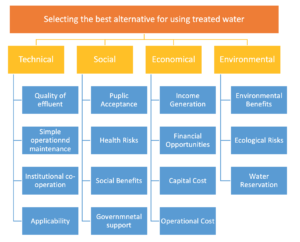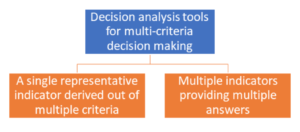
Pic credit: Startupphotos/pexel
We are often faced with alternatives or choices, prompting us to make decisions.
Making a decision implies that there are choices to be considered, and in such a case we want to not only identify as many of these alternatives as possible but to choose the one that best fits with our goals and objectives (Harris,1980).
Circular economy – Leading to complex policy decisions
In making the transition to a circular economy, we replace our current linear practice with a more regenerative alternative.
When such alternatives affect a country or an economy, their decision-making becomes quite complex. Public policy decisions are typically made not only considering criteria such as “value” typically measured through prices or financial indicators but also wider benefit to society such as “environmental quality” and “community well-being”. While some of these are measurable with money or another commodity (CO2 equivalent for example), some are not.
Let’s take an example
To understand the complexity, let’s look at the case study from Iran where there was a decision to be made by the public sector on the best reuse application for wastewater.
Given the geographical location of the country, water is a precious resource. The alternative reuse applications they had to choose between are as follows:
- Agriculture
- Industry
- Landscape
- Groundwater recharge
- Environment use
Here is how the four main criteria and sub-criteria look like when they are laid out.

In a situation like this, selecting the best alternative that is aligned with the criteria can be tricky and that is when decision-making tools come in aid.
A decision problem can have multiple criteria that affect its outcome and each of them could have different units of measure. Multi-Criteria Decision-Making (MCDM) can address the complexity of the problem in these instances.
Multi-Criteria Decision-Making (MCDM) methods – Why are they important?
1. We make decisions without considering all possible impacts.
Using MCDM in decision-making leads to thinking about and considering the impacts which we could have missed otherwise. When you understand the philosophy behind the tool you are able to engage in that line of thinking and observe all the aspects that affect the final decision.
2. We make decisions not knowing what can be assessed and what cannot.
There is a preconceived idea that these cannot be assessed, or evaluations cannot be done. They surely can be, and sometimes can be incorporated into simple decision-making tools. This is mostly the case for social and environmental aspects as monetisation is not straightforward as cost, where representative numbers can be readily identified for estimations (prices in the market for example)
3. We make decisions for the wrong reasons.
This is not something MCDM can solve, but if the reason for not considering the right criterion is due to difficulty in assessing – MCDM can help. Due to the lack of knowledge in MCDM some decisions may seem impossible. In these scenarios, decisions are being made for the wrong reasons.
But, today due to the complex nature of decisions made, many measurement tools are being developed to measure these aspects and they can be simpler than what is commonly believed.
How do you actually compare “apples and oranges”?
To understand how these tools work, here is a broad categorization we can use to simply explain.

Let’s draw our attention to multi-criteria decision-making tools and draw the simple analogy of apples and oranges.
- A single representative indicator derived out of multiple criteria.
All criteria are converted to provide a single representative answer as an aggregated indicator.
Basically, apples are converted to oranges and added to oranges to provide the total no of oranges. Cost-benefit analysis is such a tool, where all criteria are converted to monetary values to produce net present value (monetary) as the final representative result.
2. Multiple indicators providing multiple answers
You will then need to count apples and oranges distinctively and use a method to determine the decision outcome based on what is more important for you. Your decision will vary, based on what you consider as important in a complex setting.
Analytic Hierarchy Process (AHP) is one such method where you make the decision by specifying the relative importance of one criterion over another. This is used when there are a finite number of choices are involved. Based on what you specify to be relatively important, the decision will prompt different choices for you.
When the complexity of problems increase, there may be an infinite number of choices. Then there is an optimisation problem in front of us, for which we will then need to employ optimisation techniques to find an answer.
How easy or difficult is it to use these methods?
According to a survey carried out on IT companies, it was found that 71.9% of these companies knew about the existence of Multi-Criteria Decision Making methods while 33.1% used them. As opposed to MCDM methods, traditional financial methods or methods such as cost-benefit analysis were known by 89.5% and used by 74.6%.
When considering the popularity, simple decision-making tools are quite popular while MCDM methods are mostly limited to be used by experts and the academic community. (Ishizaka and Siraj, 2018).
The need for specialised knowledge to choose and apply the complex methods are attributed as reasons for their limited use.
Not only to make decisions right the first time but also to change the course
What needs to be understood is that the decision-making process matters not only at the point of making the decision but also when decisions need to be re-evaluated with the change of circumstances. Laying out a rational and well-connected systematic process helps understand how the varying factors shift the decision output to a different one.
For strategic, long-term decisions and those that affect a bigger community (such as a nation, an economy) the use of these tools is invaluable as the right or wrong decision will leave a legacy that affects generations.